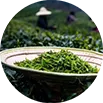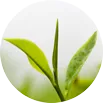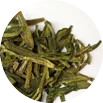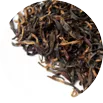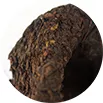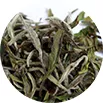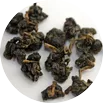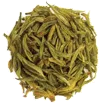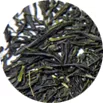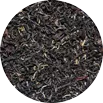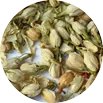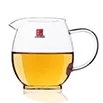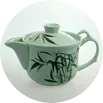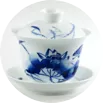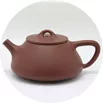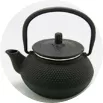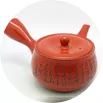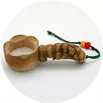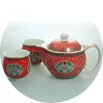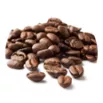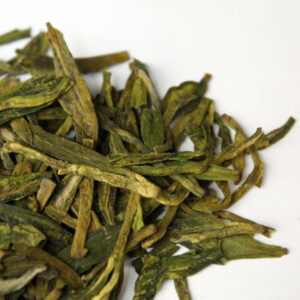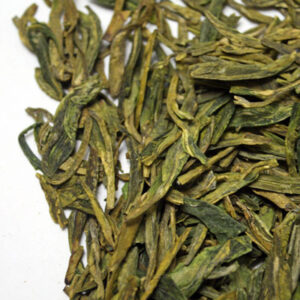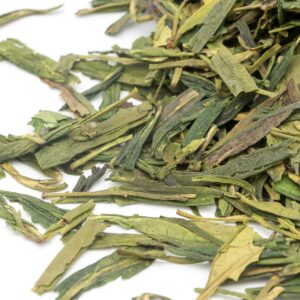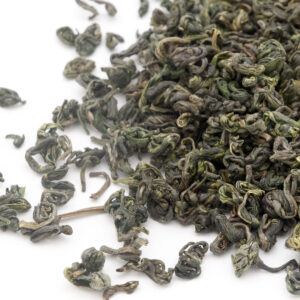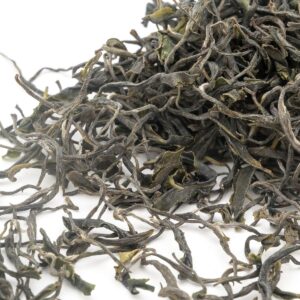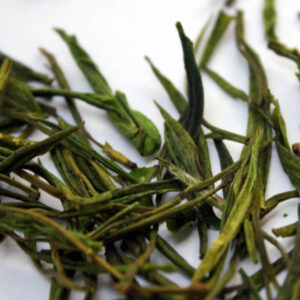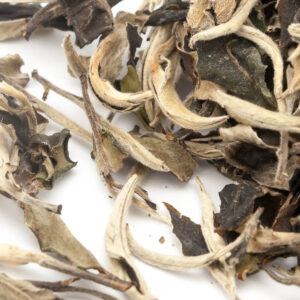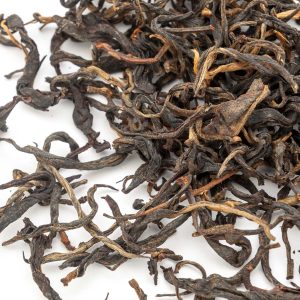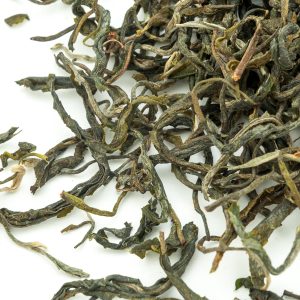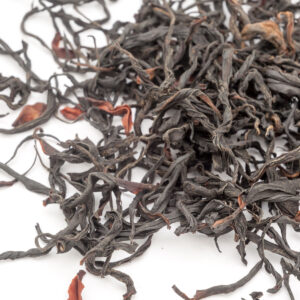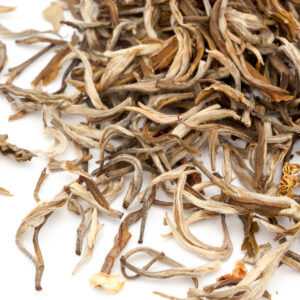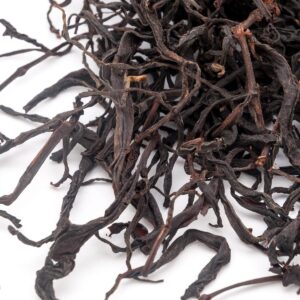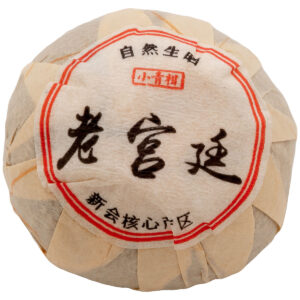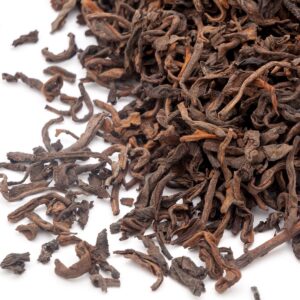Long Jing Shi Feng
"Lion's Top Dragon Well" - According to traditional Chinese view, the true Long Jing is supposed to have four characteristics (or four treasures) - a bright green color, a dense aroma, a saturated taste and a beautiful shape.
Our Shi Feng has all these qualities in abundance. To better enjoy not only the taste, but also the look of this famous tea, we recommend using a glass teapot or tall glass to prepare it. The tea is watered with water around 80-85 ° C. Tea should be handled with care, it is better to prepare it softer to maintain its delicate rich aroma.
Long Jing Xi Hu Superior
The upper class of the well-known & popular "Dragon Wells of the West Lake" (which has a total of 13 different quality classes). Authentic Lung Ching is supposed to be processed only by hand, which requires a lot of skill and time, and thus increases the price of tea.
However, the quality of such tea corresponds to the price. Dragon wells of higher varieties give a crystal clear drink of a tender emerald color with an aroma as dense as orchids and a fresh saturated taste with fruit tones.
Long Jing Xi Hu
"Dragon Well from West Lake". Lake 'Xi Hu' is located near Hangzhou in eastern China. The monastery plantations around it were known from the time of the Classical Book of Tea by Lu Yüe (758 AD).
Lung Ching belongs to spring teas and the best collection comes from the same period. The process of sorting, drying and roasting should be followed exactly for the production of real Lung Ching. The tea has flat leaves, a strong aroma and is sweet and beautifully fragrant in the infusion.
Dian Hong Jin Zhen
"Golden Needles" - an excellent variety of red tea from the Feng Qing area of Yunnan Province. The content of "Da Jin Hao" or "big golden tips" is about 60-70%.
Richly hairy tips are evenly rolled. The color of the infusion is dark orange-red and remarkably clear. The aroma is more balanced and intense than in the Dian Hong Gong Fu class and you can smell the aroma of dried apricots, forest honey and peaches.
The taste is very penetrating & delicate. The tea lasts many infusions, aftertaste persists in the mouth for a long time after drinking. Very good as a warming tea, which makes it especially suitable for drinking in the cold months of the year. For casual tea lovers, it does have euphoric effects.
Song Luo Ji Pin
A selection class of tea from Song Luo mountain, which is honored with the title "Green Gold" among the famous teas of China.
The crystal-clear infusion is strong, slightly grassy and has a sweet taste of Chinese olives. Tea processed only from tips is strong, dense and contains a considerable amount of fine fluff. Not only does this tea have an excellent color, aroma and taste, but it also contains many substances that a person needs. According to research, it has a high content of vitamin C (up to 170 mg / 100 g), it also contains up to 17 types of amino acids, organic compounds and minerals that have both nutritional and healing effects.
Song Luo is recommended primarily to support digestion, also helps remove fats from the body, relieves heat and can regulate the flow of life energy. It has often been prescribed for the treatment of high blood pressure, kidney disease, cardiovascular disease, dysentery but also for the treatment of skin ulcers.
Mei Ren Lü
Meng Ding Si Bei Xiang
"The Scent of Four Cups", a popular and affordable green tea from the Meng Ding Mountains. The name of the tea derives its character with a beautiful, intense sweet aroma ... which is not all, because there are four aromas hidden in the tea, which manifest themselves gradually, with each infusion one of them, which dominates the cup, comes to the fore - hence 'aroma four cups'.
Sparkling yellow infusion sharp, slightly astringent and strong taste with an intense floral-fruity trace on the palate and with a slowly fading slightly spicy aftertaste.
An Ji Bai Cha
Tai Ping Hou Kui
"Peaceful monkey leader". Similar teas (with sharp and pointed large leaves) were made in Tai Ping before the beginning of the Ming Dynasty. But during the Qing Dynasty, one of Hou Ken's tea growers was famous for his new tea, which he named "Hou Kui - Chief of Monkeys."
The tea has flat, relatively large leaves of a bright green color with red veining and a hairy inner side. As one of the few green teas, this orchid has a quality of taste and aroma. The infusion has a slightly milky consistency and a delicate taste with orchid aftertaste. This tea, which is rightly one of the ten most famous Chinese green teas, can help relax after physical exertion, stimulate the activity of the nervous system and tones.
Lü Xue Ya
"Green snow" is a relatively new type of tea, which began to be produced in 2003. Longitudinally rolled leaves have an emerald color and a fresh green aroma.
The emerald green infusion is full of dense, balanced and slightly baked taste in other infusions with a slightly sweet aftertaste. Tea can be prepared only in relatively cold water. The leaching time must then be extended to at least 7 minutes. You can easily prepare a delicious and refreshing 'ice tea' on hot summer days.
Yue Guang Bai “White Moonlight”
"White moonlight" - known as 'white pu-erh' - a special green (sheng) pu-erh with a difference in processing, where the leaves are allowed to fade at night after harvest, instead of in the sun, as is usual in maocha. A large proportion of dull silvery, large hairy tips gives the tea an attractive appearance.
The color of the infusion is yellowish and smells mostly of herbs with a little fruit. The taste is sweet, very complex and develops with each subsequent infusion, with a bit of bitterness gradually appearing and encouraging the distinctive flavors typical of green (sheng) pu-erhas.
Dian Hong Mao Feng
"Downy tip from Yunnan" - a high grade of red tea from the Meng Hai area.
The color of the infusion is orange-red. The aroma is sweet and intense with a typical aroma of dried apricots, malt and forest honey.
The taste is full, fruity-malty with a long-lasting sweet aftertaste. Pleasantly warming tea.
Yunnan Mao Jian Ye Sheng
Fresh aromatic green tea from the gardens high up on Wu Liang Shan Mountain (1670 m above sea level). Dark green uniform leaf with a noticeable proportion of silvery tips.
The leaf has a fresh aroma with a trace of fruit, the infusion is sparkling yellow-green in colour, fresh and strong in flavour with a fruity hint and a typical trace of chestnut blossom aroma. The aftertaste in the other infusions sweetens pleasantly and the fruity taste stands out.
Translated with DeepL.com (free version)
Dian Hong Ye Sheng
Hua Cha Cui Ming
Zheng Shan Xiao Zhong
"Lapsang Souchong", or "smoked tea". A traditional, handmade tea specialty from the Wu Yi Mountains of Fujian Province. Infusion very pleasant and strong, smooth, noble smoky taste with tones of dried fruit. The aroma of pine wood and needles, typical and desirable for this tea, is fully represented and harmoniously combines with the character of the tea as a whole, from which one can already recognize the authenticity and traditional production process.
Xiao Qing Gan 2009 Xinhui
Yi Wu 2006 shu Hong Kong
Čaj byl skladován ve vlhkém skladu v Hongkongu, takže je znatelně zralejší, než jiné čaje stejného stáří.
Vůně je kvalitní "skladová" - tzn. je cítit mokré dřevo, zemitost, houby, avšak beze stop plísní.
Chuť je výrazně "mokrá" - zemitá, ve které dominují tóny dřeva a hub, zabalené do hladké sladkosti. Přesto má čaj střední plnost.
Doporučujeme milovníkům "zemitých" puerů.


